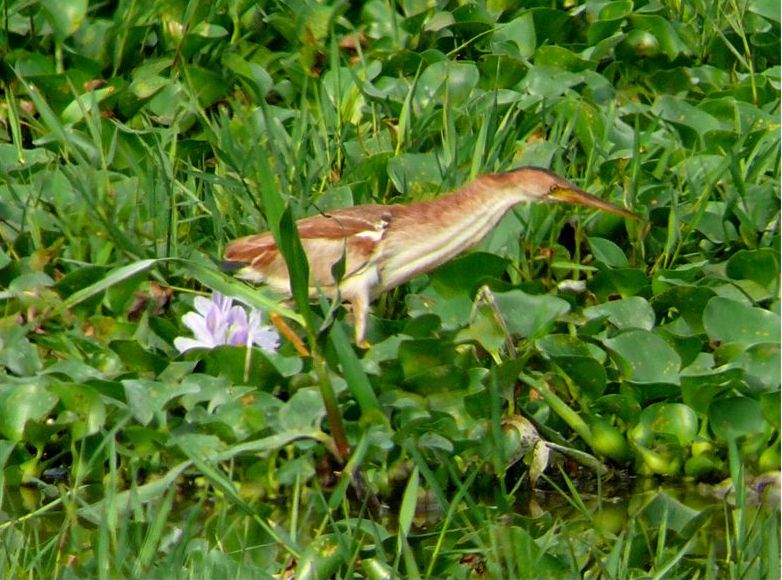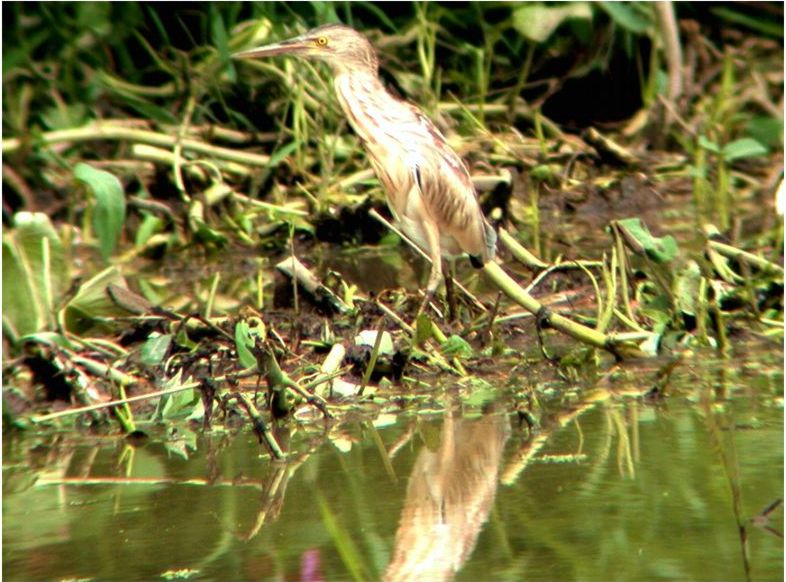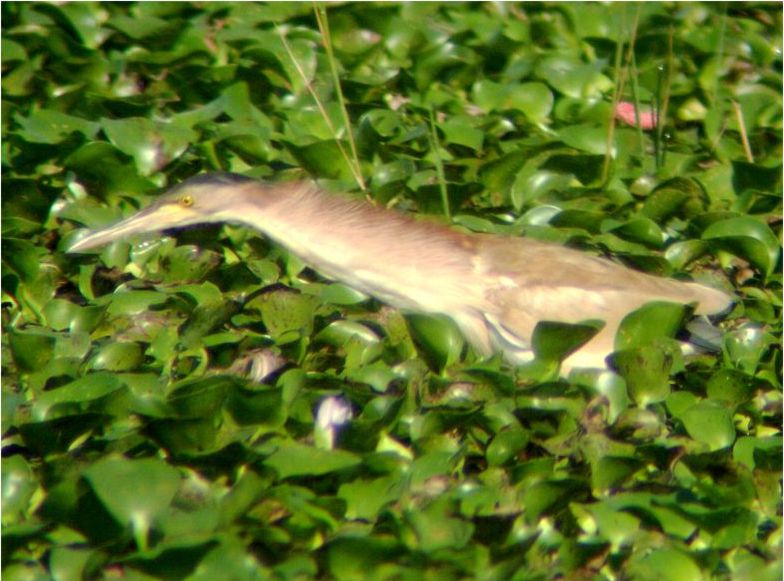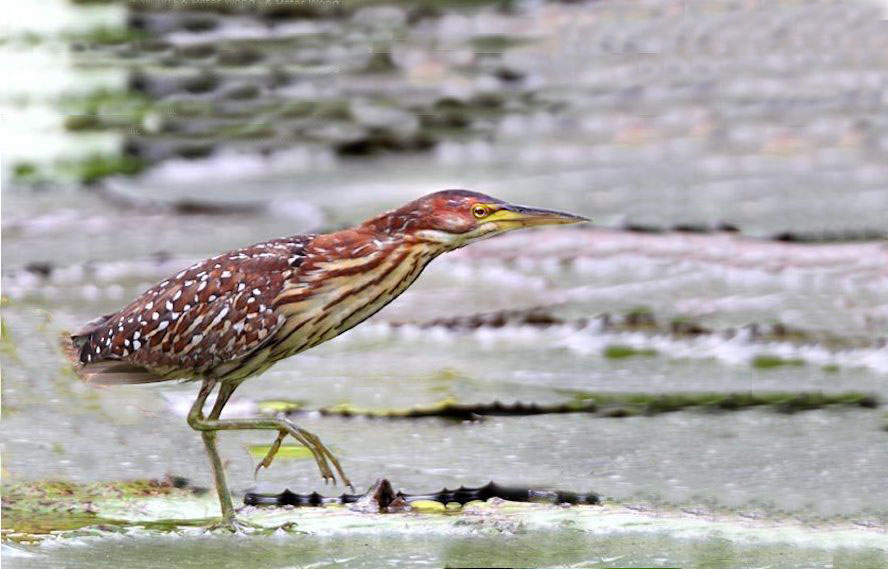Malaysian Birds
35 PELECANIFORMES: Ardeidae
Bittern birds
Malaysian Birds
35 PELECANIFORMES: Ardeidae
Bittern birds
|
Bitterns which are water birds and look like heron. In fact Bitterns are classified within the same family of birds as the Herons i.e. Ardeidae. Bitterns have shorter-neck, most Bitterns [only 2] that I met up with were secretive birds hiding and tend to fly off immediately at first sight. They hide in reed bed and stay in marshy areas looking for amphibians, reptiles, insect and fishes. Unlike Storks or herons which fly with their neck outstretched, Bitterns have their neck retracted. They are migratory in the sense that I didn't get to see them often. In any case, most Cinnamon Bitterns that I met up with were well hidden in the tall rice stalks. Yes, Bittern naturally shy, more likely to be heard than to being seen. Most of the time they have this habits of staying within the bed of water hyacinths which have rather tall leaves. Another favorite habitat is the rice fields. They, also follow a skulking pattern and weaving in between rice stalks, lastly becoming more active at dusk. In both circumstances, they will never be spotted and having a restful lifestyle. Most Bittern can be considered
to be nocturnal due this nature of hunting. Yellow & Cinnamon
Bittern is quite often seen in the daylight hours when the bird stay
exposed. However under these conditions and when the Bittern was
caught off guard and could not fly off in time, it tried escaping
attention by standing motionless with bill uplifted to point to the
sky. The beak to look just like a yellowish brown dried rice stalks.
This habit dies hard even when they are not staying within the dried
rice fields. So the Bittern was forgetting that its brown and yellow
markings and striped neck may not be blending well with the green
rice stalk. Cannot blame them having that illusion as the only time
they could be spotted in open fields would be the period of empty
fields after harvest. That time the bird's body color and stripes
blends in well with the rich golden cut grasses and ripen rice
stalks. |
| Eurasian Bittern | Botaurus stellaris |
| Yellow Bittern | Ixobrychus sinensis |
| Schrenck's Bittern | Ixobrychus eurhythmus |
| Cinnamon Bittern | Ixobrychus cinnamomeus |
| Black Bittern | Dupetor flavicollis |
|
In south-east Asia, there are only 5 species of Bitterns and all of them could be sighted in Malaysia. As I wrote earlier these shy birds are not easy to meet up with. So I this page I should be contended with the only 2 species that every one here have seen. |
Cinnamon Bittern Ixobrychus cinnamomeus
|
Size & diagnostic markings:- The Cinnamon Bitter is an average size bird at 40 cm long. The upper part is uniformly cinnamon with a hardly noticeable tiny black stripe on its crown. The under part in lighter shade, buffish has chestnut lines. It has yellowish eyes with minute facial skin and the eyes turn red at breeding time, The darl colored markings on a patch of white at the front of the wing is also an important diagnostic mark. |
| Distribution :- In a belt stretching from the Indian sub-continent, Central, East and Southern China, Taiwan and then southwards to the Greater Sundas and the Sulawesi and Philippines. |
| In Malaysia, where can the bird be found:- This bird is always found in the rice fields. When the ricestalk are green, all I got to see was they leaving their camouflage and flying to another part of the field. After harvest, the birds then were visible from a distance taking flight on being approached. |
| Habitats & preferences:- Mainly rice fields and when there is none nearby, second choice the water edge of the wetlands areas |
1 Cinnamon Bittern

2 Cinnamon Bittern
3 Cinnamon Bittern
Yellow Bittern Ixobrychus sinensis
|
Size & diagnostic markings:- The physical appearance of this slim bird appear much longer than 38 cm long., With it neck stretched very often this long necked bird is armed with a dagger like beak. Its overall is not yellow but light brown. Diagnostic is the black crown and the dark brown mantle on upper wings. Note that the female is without the dark crown and as shade under different lightings could be deceiving look for the marked patch at the wing to differentaite the Bittern. In any case those Bittern found in wetland areas are more likely to be Yellow Bittern. |
| Distribution :- Indian sub-continent, Sumatra, Philippines, Southern China, Taiwan, Korea and Japan. The bird is recorded as wintering in Borneo, and Java. |
| In Malaysia, where can the bird be found:- So far, the bird was seen in the wetland areas with water hyacinths and with bushes with tall grasses nearby. |
| Habitats & preferences:- Wetland ponds with dense vegetations, rarely at the rice fields. |
| My personal jottings on
the Yellow Bittern :-
The Yellow Bittern is less shy when compared with the Cinnamon
Bittern. This could be due to the fact that Yellow Bittern has the
habit of freezing upon being spotted. Instead of taking flight, the
first reaction would be to freeze and then slowly returns to its
routine. Birds encountered at some distance away would continue its
routine without the bird giving a notion of being startled. Don't get to see the bird for many months, could shows that the local population may be migratory. |
4 Yellow Bittern

5 Yellow Bittern

6 Yellow Bittern

Black Bittern Dupetor flavicollis
7 Black Bittern
8 Black Bittern
.jpg)
9 Black Bittern
10 Black Bittern
Great Bittern Botaurus stellaris
11 Great Bittern

Schrenck's Bittern Ixobrychus eurhythmus
12 Schrenck's Bittern
13 Schrenck's Bittern

|
|
With Will would Wander |
|